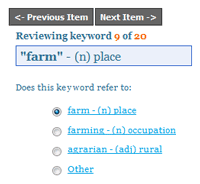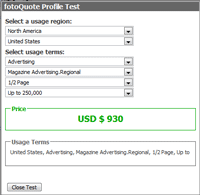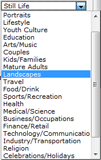PhotoShelter Collection: First Impressions
PhotoShelter was created in 2005 as an archival solution for photographers. They provide photographers with a place to store, organize, and monetize their photos for a monthly fee. On September 18th, PhotoShelter announced the future launch of the PhotoShelter Collection and invited photographers to submit photos to the Collection.
The PhotoShelter Collection is a stock photography site that positions itself between the micro-stocks and the pro-stocks. The prices (and commissions) are set much higher than a typical micro-stock agency, while the acceptance and diversity of images is higher than the pro-stock sites. The service is free to photographers, but all images must be accepted into the Collection by the PhotoShelter editors. Once accepted, photographers have a multitude of choices on how to market and price their photos.
I applied to the PhotoShelter Collection several weeks ago, and I've been evaluating their site and services. Here's my take on things thus far.
STRONG POINTS
The fact that PhotoShelter doesn't think they're too good for the non-professional photographer is simply refreshing. They welcome professional and amateur photographers to submit images for the Collection. I was actually quite surprised to find that 9 out of my 10 application images were accepted, while one received a “soft rejection”, meaning that I could resubmit with a few minor changes. I had toyed with micro-stocks about a year ago, and I found that my acceptance rate into these sites was well under 50%. It didn't take me long to figure out that I'm not a stock photographer, so I pulled all my images. I was weary of trying my hand at another stock site, but the PhotoShelter Collection seems different.
The user interface is another feature of PhotoShelter that stands out. It's simple and intuitive, while maintaining a high level of functionality. You can manage all of your incoming, pending, rejected, approved, and live photos quite easily through the web interface. Once images are approved, the site guides you through the process of adding the appropriate information such as titles, descriptions, keywords, and prices. The interface also allows you to batch process as many photos as you'd like, so you can reduce the amount of time spent on the site.

Keywording is one part of the interface that really proves to be useful. You apply keywords to an image (or bring them in with the EXIF) just like you would anywhere else. Then you're asked to clarify each keyword by associating it with a specific meaning. For example, the keyword “scooter” would give you the options of “scooter – (n) child's vehicle”, “scooter – (n) bird”, “motor scooter – (n) transportation”, “motorized wheelchair – (n) wheelchair”, and “other”. These associations don't change your original keyword, but they help identify what the image is about. It takes a bit of time to go through this process, but it gives me the sense that their search system may actually return relevant results to buyers.

Pricing is a feature that PhotoShelter has put some work into. You have the option of selling your photo as either royalty free or rights managed licensing. PhotoShelter has preloaded a few price sets for each of the licensing types to make life easier, but you can also set up your own price sets if you feel the need to make adjustments. The interface also has a feature that allows you to test your pricing, so you know exactly what a buyer will be paying for using the image in different situations. In the rights managed category, prices can range from a couple hundred dollars (maybe less) up to several thousand dollars, all depending on the end use of course. Purchases are also transparent, so you'll know where your image is being used and how it was licensed.
WEAK POINTS
It's hard to fully evaluate the strengths and weaknesses of the PhotoShelter Collection because it hasn't officially opened up for sales. So the only thing I can critique is the photographer interface portion of the site. I may come back at a later time and do another review of the site and service, but for the time being I can see a few things that need improvement.
The image review period is supposed to be 2 to 3 business days after submitting your images, meaning that they'll be accepted or rejected in that amount of time. So far, it's been closer to a week or two for turnarounds. It's a little frustrating, but PhotoShelter is at least aware of it and I'm sure they'll work it out eventually.
Uploading images is also a little dicey through the web interface. The first set of images I uploaded were half gone by the time I waited for everything to finish — I uploaded 10 and only 5 went through. I uploaded the 5 missing images again and they still didn't show up. At that point, I turned to the standalone uploading utility — a piece of software that runs right on your computer. I haven't had any problems with the upload utility, so it's best just to use that and not even mess with the web interface.

Categorizing photos is a little tough because the choices aren't plentiful. I'm finding that many of my images don't fall into any one given category, and it's a stretch to label them based on the choices given. I've seen this done better, where you choose a main category then a sub-category so you don't end up with a list of 200 choices… though I don't remember which site I saw this on. I have to say though, that I've only been able to evaluate the “Creative” categories because I'm still waiting for my “Editorial” photos to go through. I also don't know how the “Pro Stock” categories match up because I didn't place myself in that group. Regardless, more categories would make life easier for the photographers and the photo buyers.
SO IS IT WORTH YOUR TIME?
Given the fact that time is all it costs, I'd say it is. Depending on how things go when they open the site up to photo buyers in November, it could actually be quite profitable for skilled amateur photographers. It probably won't make professional photographers out of most of us, but it could provide a nice supplemental income if you sell an image every once in a while — the commission is 30%, so the photographer keeps 70% of the sale. They also don't require exclusive rights, so you can still sell your images elsewhere or share them on sites like Flickr.
If you want more information before giving it a try, check out the PhotoShelter Collection homepage, their blog, and the press release. I'd also love to hear thoughts from anybody else that's trying this thing out.


Dan Cotora
October 30, 2007Good review. Thanks for writing about it.
Jeffrey Friedl
November 10, 2007I think you meant to say that the commission is 30%, not 70%. They take 30%, you get the remaining 70%.
Brian Auer
November 10, 2007Thanks for catching that Jeff, I’ve updated the text.
Ryan R. Dlugosz
November 10, 2007Good summary of the PS Collection offering. I’ve got just a couple of images loaded there and will be interested to see how it goes.
I’m not a fan of the Microstock model. I feel that it seriously under values photographers and preys upon some naive notion that people want to feel “successful” by “selling” images. The fact of the matter is that they made a halfway decent photo (in some cases an outstanding photo) and sold it for a fraction of what a buyer would have been willing to pay just a few years ago. Kind of a shame – hurts the industry as a whole and the people benefiting the most are the owners of the company, not the photographers.
Anyway, I think the PSC model could work and be a good place to sell images as long as they can get buyers in the door. The best thing that they can do is to keep the editing tight & not let in sub-par imagery… If they keep it tight, buyers may be willing to shop here instead of the micros.
Andy Frazer
November 10, 2007I was not impressed with PhotoShelter.
After accepting their “free” offer (NOT!), I signed up, uploaded twenty photos, tagged them as described in their documentation, waited two days for their judges’ evaluation (16 of my 20 got accepted), set my prices (after digging through more documentation), set my license types, then checked back a few days later.
None of them were in the collection available for sale. Why not? Digging through more documentation… then I found out that unless you purchase a membership (remember, I was using the “free” membership), you need to pay the one-time $50 fee to enable your photos for sale.
I was so ticked off, I deleted all my photos and told every photographer I know about my experience.
Two of my friends (one is a full time photographer), told me that she gave up on PhotoShelter because the step-by-step directions were too complicated. I don’t blame her. I almost gave up myself.
So, I’d like to add two more weak points to their list:
1. Their “free” membership is a misnomer (at best). Expect to pay $50 to enable your “free” account, and you might never earn that back in commissions.
2. Their documentation is complete, but difficult to understand.
I’d like to hear other people’s experiences with PhotoShelter.
Andy
Brian Auer
November 10, 2007I think you’re referring to the regular PhotoShelter service, while I’m talking about the PhotoShelter Collection. It took me a little while to figure out the difference between the two, but they’re separate services. PhotoShelter is a place for photographers to store their images and make them available for sale, but there’s a storage fee for the photographer. PhotoShelter Collection is free for photographers, and acts like a stock agency. The selling part of the site isn’t live quite yet, but it will be in a few days.
Mark Scheuern
November 10, 2007Yes, Andy is wrong on several counts. The images were not available in search because the site doesn’t go live for buyers until Monday. Like Brian said, he’s confusing the PhotoShelter Collection with the PhotoShelter Personal Archive. The PhotoShelter Collection is definitely free. And, frankly, I find the instructions for the Personal Archive simple enough to follow and the explanation of what’s offered with the free Personal Archive clear enough.
I agree that categorizing is tricky right now because of the lack of categories. And I certainly do hope this helps wean people from the microscam sites.
Andy Frazer
November 10, 2007Brian,
Thanks for your comment. But, no, I am pretty sure I’m referring to the stock agency part of PhotoShelter (https://www.photoshelter.com/collection). As I pointed out in my first comment, I went through process of being approved by the judges for selling images, setting the stock prices, and setting the resale license types, and tagging the images for (potential) sale as described in their documentation.
There’s even a paragraph in their documentation about this one-time “enable account for sale” fee is part of their stock agency system: https://www.photoshelter.com/fees
Thanks for trying to clarify it, though.
Andy Frazer
Brian Auer
November 10, 2007Those are the fees for their eCommerce solution within the PhotoShelter Personal Archive. The PhotoShelter Collection is a different deal, and it’s only intent is to sell images. Here’s a quote from their FAQ page within the members area:
I haven’t been asked to pay anything for using the service. So far, the statement above has been true for me and a few others I know that are loading images into the collection.
Matt
November 11, 2007Andy, click that link you just gave (photoshelter.com/fees). What does it say in the top-right corner of the screen under About-Cart etc.? It says “Photoshelter Personal Archive”.
Since you’ve already gone through the approval process, it shouldn’t be too much of a pain to throw some images back up there for the collection if you want to give it a whirl. The site only goes live tomorrow (Nov 12th).
For what it’s worth, I’ve had moderate success on a couple microstock sites as an amateur. It will be interesting to see if this business model is more profitable. With the micro sites, you sell 100’s (or 1000’s) of images per month. I think I’d be happy to have one per month on Photoshelter!
Brian Auer
November 11, 2007Yeah, sales are definitely going to be less in quantity of images, but hopefully they’ll make up for it in quantity of dollars.
Andy Frazer
November 15, 2007Well, don’t I feel stupid, now. You’re all correct. I was in the Photo Shelter Personal Archive when I should have been in the Photo Shelter Collection. My bad. My photos are now in the P.S. Collection, they’re searchable, and they’re ready for sale.
If only there was a way that I could retract my original comment.
Andy Frazer
Brian Auer
November 15, 2007LOL, don’t feel too silly — I KNOW you’re not the only one out there to be confused by PhotoShelter’s site structure. Good luck with the photos, let us know if you make anything from the site — I’m really curious to see how things go for everybody.
linli
June 5, 2008yes, no worries andy! i had the same comment as you and now I’m glad to know it IS “free”